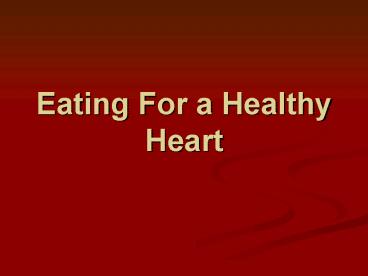Eating For a Healthy Heart - PowerPoint PPT Presentation
1 / 31
Title:
Eating For a Healthy Heart
Description:
Normal blood lipid levels and blood pressure can help lower that risk ... Choose foods that are baked, broiled or grilled, not fried ... – PowerPoint PPT presentation
Number of Views:308
Avg rating:3.0/5.0
Title: Eating For a Healthy Heart
1
Eating For a Healthy Heart
2
Control of blood fats or lipid levels is a major
reason for meal planning
3
Diabetes increases your risk of developing heart
disease
- Fats contribute to heart disease
4
What else can increase risk of heart disease?
- Age
- Family History of Heart Disease
- High Blood Pressure
- Abnormal Blood Lipid Levels
- Diet High in Saturated Fat
- Physical Inactivity
- Weight/ Body Mass Index Above 26
- Smoking
- Stress
5
People with diabetes are 2-4 times more likely to
have heart and circulation problems
- Normal blood lipid levels and blood pressure can
help lower that risk
6
Blood lipid goals for those with diabetes
- Cholesterol less than 200mg/dl
- LDL less than 100mg/dl
- HDL greater than 60mg/dl
- Triglycerides less than 150mg/dl
7
Blood cholesterol levels are genetically driven
and affected by long-term intake of unhealthy
fats
- Triglycerides are elevated by high dietary fat
intake and by glucose intolerance
8
Four Types of Fats
- Saturated
- Polyunsaturated
- Monounsaturated
- Transfats
9
All Fats
- Are high in calories
- Contribute flavor and texture to foods
- Provide a sense of fullness
- Have an insignificant affect on blood glucose
levels
10
Different people need different amounts of fat
depending on their blood lipid goals and their
weight
11
Once digested, saturated fats and trans fats are
packaged by the liver into LDLs. Saturated and
transfats increase blood cholesterol
- The circulating LDLs adhere to sticky places
along the walls of blood vessels causing a
buildup of plaque. The plaque can then narrow
the blood vessel restricting blood flow to the
heart
12
Sources of Saturated Fat
- Animal Proteins Cheese
- Milk Butter
- Eggs Ice Cream
- Sour Cream
- Palm and coconut oil
13
Transfats
- Created during the process of turning vegetable
oils into solids - Listed in the ingredients as hydrogenated or
partially hydrogenated fat - Found in baked goods, fast food, convenience
foods
14
Polyunsaturated Fats
- Do not raise LDL cholesterol, may lower blood
cholesterol, may lower HDL cholesterol - Include heart healthy omega 3s found in fish,
flaxseed, and soybean oil - Sources
- Vegetable oils Mayonnaise
- Salad dressing Walnuts
- Sesame seeds
- Soft tub margarine
15
Monounsaturated Fats
- Lower LDLs and Raise HDLs
- Sources
- Olive oil Canola oil
- Peanut oil Olives
- Avocados Peanuts
- Almonds Cashews
- Pecans Sesame seeds
- Peanut Butter
16
HDL cholesterol helps remove cholesterol from the
blood
- The higher your HDL levels, the lower your risk
of heart disease
17
Cholesterol
- Essential for the body
- The body manufacturers all that it needs
- Found in all foods that come from animals
- Meat Cheese
- Egg yolk Whole or 2 milk
- Ice cream
- Recommended daily limit 300mg/day
18
The amount and type of fat as well as the amount
of cholesterol in your diet affects the
cholesterol levels in your blood
- Cholesterol in food may increase the cholesterol
in your blood
19
Guidelines for limiting fat intake
- Choose poultry, fish and lean meats
- Use skim or low fat milk
- Limit egg yolks
- Limit organ meats
- Limit high fat animal products as in bacon,
cheese, butter, hot dogs - Limit baked goods and snack foods
- Use healthy oils when cooking and in dressings
and sauces
20
Eat more fruits, vegetables and whole grains
- Choose foods that are baked, broiled or grilled,
not fried
21
Many low fat and nonfat foods can be found in the
stores
- Read labels carefully these products may be
higher in carbohydrates than the food they replace
22
Also keep in mind
- low fat does not mean low calorie
23
Concerned about triglycerides?
- Replace some carbohydrates with monounsaturated
fats to help lower blood glucose levels and
triglycerides
24
Fiber and Cholesterol
- Fiber is the indigestible part of plant food,
providing no calories or blood sugar - Insoluble fiber found in whole grain, fresh
fruits and vegetables, speeds up the passage of
food through the digestive system - Soluble fiber found in beans, legumes, fresh
fruits and vegetables, speeds up the passage of
food through the digestive system - Fiber has been found to lower blood cholesterol
levels
25
25-35 grams of fiber every day is recommended
26
High Blood Pressure Has Significant Health
Consequences
- Blood Pressure Goal
- Less Than 130/80
27
What can you do to lower blood pressure?
- A diet high in fruits, vegetables and whole
grains - Supplement omega 3 fatty acids if you do not eat
fish at least twice a week - Exercise
- Reducing dietary sodium
28
Reduce your sodium intake by eating less of
- Canned vegetables
- Canned soups
- Deli meats
- Pickles
- Olives
- Table salt
- Convenience foods
- Cheese
- Soda
- Convenience foods
- Restaurant food
- Chips
- Salted pretzels
- Popcorn
29
To reduce sodium intake you can eat smaller
portions of high salt foods, eat them less often,
or substitute other foods
30
Remember!
- Small changes can make a big difference
31
Nutrisense Inc.Amy Shapiro R.D., C.D.N.
- 373 Route 111
- Smithtown New York 11787
- (631) 979-6699































